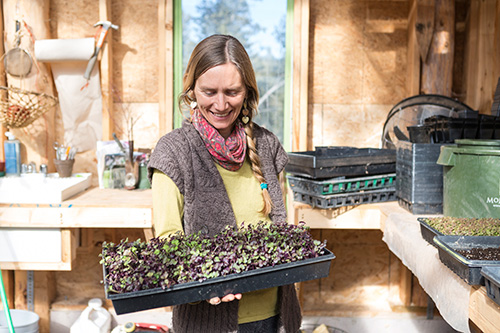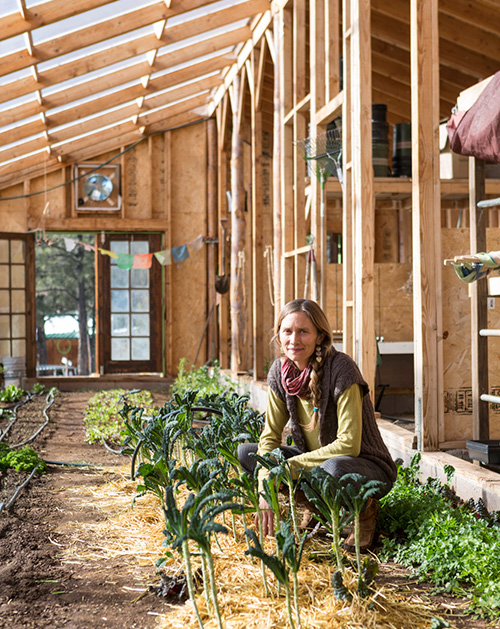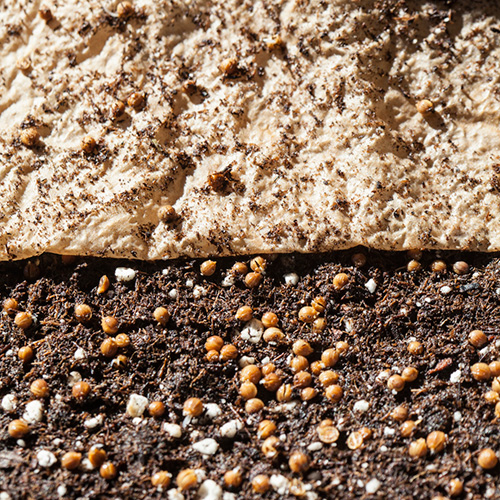
Three Sisters Farm
Nestled up in the pine-lined inclines of Glorieta is Aimee Putnam’s Three Sister Farm. Named after the three cornerstone crops of Native American agriculture – squash, maize and beans – her produce is primarily defined by the color green – lettuce, braising mix, kale, chard, parsley, herbs, edible flowers. In the winter, Aimee focuses on the tiny vegetable seedlings of various plants we know under the umbrella term, “microgreens”.

© Gabriella Marks
The location is unusual for a farm – most farms bringing produce to market in Santa Fe are based in the valleys just north of town – Dixon, Alcalde, Velarde, Pojoaque – and south along the greenbelt of Cerrillos. But Glorieta is surprisingly well suited to growing. The micro-climate and geographic qualities of the mountain pass result in a higher annual rainfall than other nearby regions, a benefit that Aimee, originally from the water-rich Northwest, is keen to maximize. All irrigation is supplied from over 6,000 gallons of rain catchment cisterns. For Amy, whose greenhouse is akin to a sanctuary and whose approach to gardening borders on meditative practice, “water from the sky”, rather than drilled from the ground, is central to her grower’s philosophy.

© Gabriella Marks
When that rain turns to snow, greens are grown in a beautifully designed 30’x60’ passive solar greenhouse. Funded in part through a grant from the Santa Fe Farmer’s Market Institute and designed and constructed by her builder husband, the structure is typically a good ten degrees warmer than outside. Large leafy greens are insulated in the warmer ground, and covered at night.

© Gabriella Marks
The microgreens are grown in a peat medium in flats. Aimee has been experimenting with a coco-peat medium made from coconut husks, in an effort to minimize the depletion of sphagnum peat moss bogs. She explained something I hadn’t known previously: peat moss is mined by scraping off the top layer of living sphagnum moss in bogs, which destroys fragile habitats, and the process of restoring bogs is slow. It’s interesting to consider – notions of “healthy food” are so often focused on the benefits to the eater. Even when we eat well, it’s essential to understand the environmental and socio-economic impact of our choices.

© Gabriella Marks
And microgreens are the epitome of eating well: research has shown that these tender leaves have 4-6 times higher concentrations of key nutrients – Vitamins A, C and E, and carotenoids – than mature leaves of the same plant. The magic to this nutritional concentration are the cotyledon, tiny leaves which are the embryonic first leaves of a plant, and contain all the energy and nutrients needed to grow the mature plant. The decision to grow mircogreens is both practical and intuitive – given the modest growing areas she has, small makes big sense. And for Aimee microgreens symbolize “living food”. As someone who has studied birthing and midwifery in addition to being a farmer, and a mother of two, nurturing life is central to everything she does.

© Gabriella Marks
You can taste Aimee’s healthy microgreens and other crops in your weekly Blossom Bag, shop online at: https://squashblossom.localorbit.com. Squash Blossom Local Food founder, Nina Yozell-Epstein says, “We’re thrilled to carry Three Sisters Farm produce, especially in these winter months. Having the vibrant, vital, nutritious greens and herbs keeps our spirits up and our patrons healthy!”
Squash Blossom Stories on eatsantafe.com is a collaborative project to promote growers and chefs in northern New Mexico.
You can see more photographs of Three Sisters Farm on my website at: http://gabriellamarksphotography.com/three-sisters-farm


